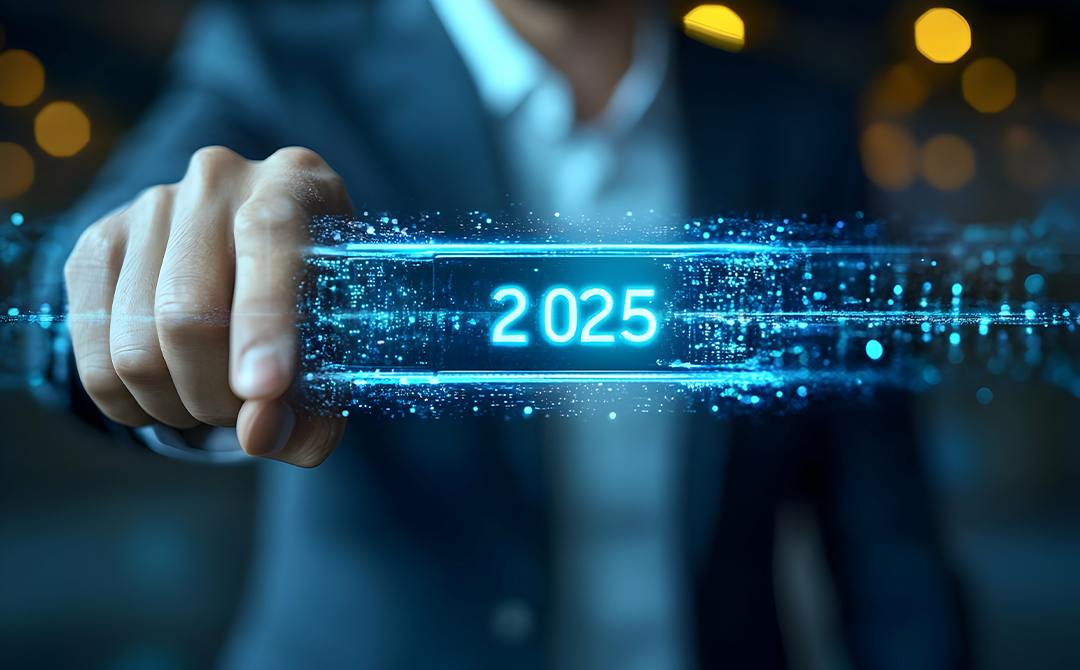
AI is constantly evolving, but is your business evolving with it?
2025 marks a pivotal shift for AI in business, where cutting-edge advancements are not just automating complex tasks, but are fundamentally reengineering enterprise strategy and operations. From intelligent agentic AI architectures to hyper-personalized predictive models, AI innovations have enabled companies to operate faster, smarter, and more efficiently than ever before. But with continuous innovation, comes competition as companies are battling to dominate the AI market, innovate faster, and drive maximum value to customers.
For companies aiming to stay ahead, understanding and leveraging key AI trends to unlock new growth opportunities and secure a powerful competitive advantage is critical for success. So, let’s dive in and explore some of the top AI trends making headlines in 2025!
Exploring Emerging AI Trends in 2025
AI’s evolution has led to the emergence of new technologies that push the limits of what machines can do. Let’s take a look at a some emerging AI trends:
Agentic AI
Agentic AI is one of those artificial intelligence systems that operates on a high degree of autonomy, making its own decisions and taking actions independently to achieve set goals. Typically composed of multiple components or “agents,” each have a specialized role from information processing and using advanced models to determining the best course of action to achieve goals. Unlike other AI technologies that respond to prompts and operate under predefined rules, Agentic systems, at present, can perform autonomous tasks, contextually understanding multiple data forms. Rather than simply reacting to user requests, it can anticipate needs, set its own sub-goals, and proactively work towards achieving broader objectives.
For instance, Agentic AI in 2025 has the ability to enable self-driving cars to make real-time decisions and seamlessly navigate complex traffic patterns. AI-powered trading bots created by agentic AI can analyze market data, identify profitable trading opportunities, and automatically execute trades.
In short, Agentic AI is still evolving and marks a significant revolution in the field as data scientists look to execute tasks and complete projects without any manual intervention. And this technology is expected to become prevalent in the future with 33% of enterprise software applications incorporating it by 2028. Source
Multimodal AI
Imagine a virtual healthcare assistant that can simultaneously analyze a patient’s symptoms, review their medical history, and interpret real-time medical images like X-rays or MRIs. This is a form of Multimodal AI where machines can process, integrate, and analyze multiple data types such as text, images, audio, etc. Unlike traditional AI models that can only handle a single data type, multimodal AI integrates multiple data types to deliver more accurate and richer outputs.
This AI model is making significant breakthroughs in 2025, from healthcare to even everyday technologies used at home. Virtual assistants and chatbots can now be fed visual cues beyond spoken commands to make interactions more intuitive. For example, if you received a defective product from an e-commerce site, you can upload a photo of the product to the customer support chatbot. Equipped with computer vision capabilities, the chatbot can analyze the image, identify the product, detect the specific issue, and offer relevant responses such as offering replacements, refund, or troubleshooting steps. Search engines also allow users to feed images or voice when entering search queries for more precise results.
Generative AI as a commodity
As generative AI increasingly becomes more accessible through off-the-shelf APIs and foundational models, the differentiation is no longer on who has access to generative AI. It’s about who can fine-tune the models using proprietary data, integrate them across their functions and enforce compliance. Its success is dependent on it being an indispensable commodity by way enterprise operationalizes it responsibly and contextually.
Beyond experimentation, 2025 has marked a turning point in how AI is adopted across industries. Generative AI is now being deployed in targeted, ROI-driven ways, moving from proof-of-concept to practical, value-generating use cases. It’s no longer the exclusive domain of tech giants. Thanks to accessible APIs and platforms, small businesses and even individual users are tapping into the generative AI trend to streamline workflows, spark creativity, and drive measurable outcomes. The competitive edge now lies not in access, but in how well organizations can operationalize AI strategically, responsibly, and at scale.
Ethical AI
As organizations design and deploy AI systems, there’s also the business case of responsible AI, making it an essential building block for transparency, accountability, and fairness. Today, ethical AI is deeply woven into the fabric of enterprise AI governance, no longer an afterthought, but a strategic priority on par with cybersecurity and data privacy.
This shift is reflected in the formation of Responsible AI teams, rigorous auditing and continuous training of datasets to detect and correct bias or model drift, a strong emphasis on model transparency, and the integration of explainability within deployment pipelines. These measures are critical not just for compliance, but for building trustworthy AI systems that can operate reliably and equitably at scale.
For instance, in healthcare, AI systems are trained exclusively on peer-reviewed medical data to provide accurate and unbiased health information. In banking, algorithms used in fraud detection and credit scoring are subject to fairness audits to ensure applicants are given fair treatment and reviewing. Global bodies like UNESCO are also governing AI tools for bias and transparency, promoting ethical use of AI in education. Source
Quantum AI
Quantum AI is an emerging field that combines the power of quantum computing with artificial intelligence to solve problems that are too complex and time-consuming for traditional systems. Think of it as integrating a supercharged quantum engine into your AI strategy, allowing your systems to process massive datasets and retrieve insights at unimaginable speeds. But how does it work?
Quantum computers use qubits, the fundamental units of quantum computing to process and store data. Qubits can represent both 0 and 1 at the same time, unlike classical bits that can do either 0 or 1. They allow quantum AI algorithms to parallelly explore many possible solutions, speeding up tasks like simulation and pattern recognition.
For example, finding and optimizing the best distribution routes might be a challenge for supply chain leaders, especially when hundreds of deliveries might be involved. Quantum AI can solve this “needle in a haystack” problem by analyzing all possible routes simultaneously and finding the most efficient solution in minutes.
However, Quantum AI is still in its early stages of development and could take a few years to fully mature. Its market size is also expected to grow at a 39% CAGR between 2024 to 2025. Source But its potential can be a game-changer as technology continues to evolve.
Industry Specific Applications of AI
AI trends for 2025 are reshaping the way organizations across multiple industries interact with AI, marking its shift from being a supportive tool to an integral part of their tech stack. Let’s look at some of those industries and a practical example of AI’s applications in each:
Retail & E-commerce
Did you know that the market size for global AI in retail is projected to reach $85.07 billion in 2032 from $9.36 billion (2024)? Source Consumer expectations have never been higher as shoppers today prefer more personalized and seamless experiences across all channels. This is where the latest AI trends step in, benefitting both retailers and customers in many ways:
- Personalized shopping experiences: By carefully analyzing vast datasets such as purchase histories and behavioral patterns of customers, AI algorithms can send personalized recommendations and strategically place relevant products for them as they browse.
- Customer engagement: AI chatbots and automated messaging provide instant responses to customer queries and assist with order tracking, proactively engaging customers throughout their buyer journey.
- Inventory management: With AI-powered demand forecasting, retailers can predict market trends early on, avoiding issues like overstocking and stockouts.
- Frictionless checkout: AI is used in cashier-less stores and automated payment systems to create smooth checkout experiences for customers. Store operations are also seamlessly managed by AI, ensuring minimal human involvement is required for it.
Case Study
Let’s go deeper and see how Tredence helped the 3rd largest convenience store chain in the US successfully establish a data and analytics CoE for maximum efficiency!
Problem statement
The client wanted to establish a data and analytics Center of Excellence and reshape their retail operations.
The Solution
Tredence and the client teamed up to implement a flywheel partnership model with a cross-functional team of data engineers, architects, business analysts, and retail experts. The team focused on key project areas: Data foundation, Data governance, Community of analysts, and AI/ML solutions.
Bottom-line Impact
The retail outlet achieved:
- Over $1 million in cost savings
- 10% improvement in forecasting accuracy resulting in over $5 million savings and 5% reduction in spoilage
- $15 million worth of grocery and general merchandise shrinkage identified through inventory and asset-based transaction monitoring
- Improvement in online assortment from 400 to 1500 + SKUs per store, creating a better guest experience and increasing share of wallet.
Financial services
The banking and finance sector has experienced profound changes in operations and decision-making as organizations are increasingly turning to sophisticated AI technologies. CFOs, in particular, have expressed optimism as 85% of them believe AI’s potential for efficiency gains, though 61% of finance teams are yet to integrate it into their workflows. Source
- For starters, AI algorithms analyze transaction data in real-time to detect potential frauds and support risk assessment measures.
- Algo-trading systems leverage AI and ML algorithms to automate and refine trading strategies. They identify trading patterns, analyze market movement, and execute trades at higher speeds and accuracy.
- AI is extensively used in credit scoring to determine a borrower’s creditworthiness.By analyzing historical borrowing data, transaction patterns, and social media activity, AI can make accurate credit risk assessments and influence lending decisions accordingly.
- AI automates the generation of financial reports, regulatory filings, and compliance tasks to help organizations keep up with changing regulations.
Case Study
Here’s how Tredence helped deploy an AI/ML-enabled solution for improving lead effectiveness for a major payment cards company
Problem statement
A global leader in business payments with 800k+ merchants, the client’s marketing team reported duplication issues within their consolidated lead database as a result of sourcing leads from 3rd party firms.
To tackle this problem, the client wanted an AI/ML-enabled Deduplication solution that could process the leads with speed and accuracy, also cutting down the time-to-market.
The solution
- Within the client’s AWS environment, Tredence designed a completely automated and scalable solution.
- Custom AI/ML algorithms were used to deduplicate millions of leads with maximum accuracy
- Lead prioritization engine was built on top of the Dedup engine to ensure actionability
- The solution tracked funnel movements, enabling the client to course-correct outreach strategy
The Result
Lead processing time was significantly reduced to just a few hours from an earlier 1-2 months.
Travel and hospitality
Increasing number of travelers and technological advancements in travel and hospitality has compelled firms within the industry to differentiate themselves from one another. This is where AI steps in to redefine business processes that align with guest preferences, improve customer loyalty and deliver memorable travel experiences.
- Dynamic pricing: An impactful application of AI trends in this sector, airlines, hotels, and travel platforms can dynamically adjust rates based on demand trends, seasonality, and competitor prices. Pricing offers are also personalized based on customers’ booking history and loyalty status.
- Virtual assistants: Aside from handling reservations and customer queries 24/7, AI-powered sentiment analysis tools are also being improved upon in 2025 to gauge customer satisfaction through guest feedback, reviews, and social media mentions.
- Guest engagement: AI can analyze guest data to provide tailored recommendations for seamless and customized stay. Many hotels even use virtual concierges and chatbots to enhance guest engagement.
Case Study
Let’s look at how Tredence helped a major cruise line address travel demand surge and enhance customer experience:
Problem statement
The cruise line’s existing systems could not handle surges in data and customer expectations. They needed a system to consolidate customer data, identify personas, and personalize customer experiences.
The solution
By partnering with Tredence, the cruise line used AI/ML-powered solutions to modernize its marketing model, leveraging the former’s expertise in customer analytics and journey-based marketing. Tredence’s value-added approach encompassed the following:
- Building a unified customer data model for a 360-degree view, resolving ID issues, and automating core processes
- Guiding the shift to customer-centric marketing with AI/ML accelerators and a self-service CDP
- Implementing CDP and LEAF data model for centralized customer 360 data
- Enhancing marketing efforts by focusing on customer journeys using analytics and personalization.
- Empowering marketers with historical campaign analysis, 360-degree campaign view, optimizing budgets, and unifying measurements.
Bottom-line impact
Through Tredence’s AI/ML-powered solution, the cruise line was able to achieve:
- Budget savings of $8 million
- 250 TB of weekly processed data
- 200+ customer features
- Anonymous customer matching accuracy of over 35%
- 5% increase in key journey conversion
- 15% improvement in ROI
- 5x faster campaign setup
Wrapping Up
As we progress through 2025, the future of AI for businesses is bursting with infinite possibilities. AI innovation is accelerating at record speeds, from generative AI being widely used as a commodity to AI agents that can operate on their own without human intervention. These technologies are reshaping the way several industries operate while ensuring they also deliver value and stay competitive.
If you’re a company looking to turn those bold AI predictions into real-world success, Tredence’s broad portfolio of AI services can help you create the best AI strategies and derive actionable insights out of them. Our domain-based AI consulting services, engagement models, change management, and KPIs also help you unlock business value and plan your AI projects better.
Get in touch with us today to learn more about how our portfolio of services can help you stay ahead of AI trends and create value for your customers!
FAQS
1] What are the key AI trends businesses should focus on in 2025?
Businesses today should prioritize agentic AI, multimodal AI, generative AI, and ethical AI practices. These tools can create intelligent systems that act automatically, process diverse information, generate new content, and operate in a fair and responsible manner.
2] How can businesses leverage AI for competitive advantage?
To stay ahead, businesses should integrate AI into their tech stacks for better efficiency. AI plays a key role in automating repetitive tasks, enhancing customer experiences, accelerating innovation, promoting data-driven decision-making, and boosting cost-savings.
3] What are the potential risks of relying on AI as an organization?
There are several risks AI may pose such as algorithmic bias leading to unfair outcomes, cybersecurity vulnerabilities, potential job disruptions, and lack of accountability. Hence, AI should be used wisely keeping business goals in mind and maintaining human interactions and skills.

AUTHOR - FOLLOW
Editorial Team
Tredence
Next Topic
Why 85% of Enterprises Struggle to Adapt to Responsible AI (and What You Can Learn from the 15% Who Succeed)
Next Topic




